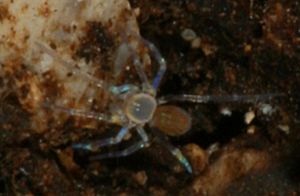Tooth Cave spider facts for kids
Quick facts for kids Tooth Cave spider |
|
|---|---|
 |
|
| Tooth Cave spider from Gallifer Cave, Travis County, TX | |
| Conservation status | |
| Scientific classification | |
| Synonyms | |
|
The Tooth Cave spider is a tiny spider, only about 1.6 mm (0.063 in) long. It belongs to a spider family called Leptonetidae. This special spider lives only in certain limestone caves near Austin, Texas in the United States. Because it's found in so few places, it is considered an endangered species. Its scientific name is Tayshaneta myopica. It used to be called Neoleptoneta myopica.
Contents
How Scientists Name Spiders
The Tooth Cave spider was first described in 1974. A scientist named Willis J. Gertsch gave it the name Leptoneta myopica. At that time, it was only known to live in Tooth Cave in Travis County, Texas. This cave is about 15 miles northwest of Austin.
The second part of its name, myopica, comes from an old Greek word. It means "nearsighted." This name was chosen because of how its eyes looked.
Later, in 1977, another scientist, Paolo Brignoli, moved the spider to a different group. He put it in the genus Neoleptoneta. So, its name changed to Neoleptoneta myopica.
In 2011, scientists did a new study. They looked closely at the family of spiders the Tooth Cave spider belongs to. They found that the Neoleptoneta group wasn't quite right. Because of this, they created several new groups, or "genera." The Tooth Cave spider was then moved to a new genus called Tayshaneta. That's why its current scientific name is Tayshaneta myopica.
What Does It Look Like?
The Tooth Cave spider, Tayshaneta myopica, is very small. Its body is only about 1.6 mm (0.063 in) long. Even though its body is tiny, it has long legs. Its first leg, which is the longest, is about 4.3 mm (0.17 in) long. The shortest leg is the third one, measuring about 2.9 mm (0.11 in).
This spider is mostly whitish in color. Some parts of its body might be a little yellower. It has six eyes. Four of its eyes are at the front of its head, and two are behind them.
When the spider was first found, its eyes were described as "obsolescent." This means they were not fully developed. They also didn't have dark color. However, scientists later found that these spiders can look different. Some have no color in their eyes and are blind. Others have dark eyes and can see well.
Where the Spider Lives
In 2012, the Tooth Cave spider was found in caves in Travis County and Williamson County. These areas are northwest of Austin, Texas. Scientists have found the spider in at least six different places. The exact locations are kept secret to help protect the spiders.
These caves are in a special area called the Edwards Plateau. This region in Central Texas is made of limestone. This type of rock forms unique underground spaces called "karst" regions.
Tayshaneta spiders usually spend most of their lives in their webs. Only the adult males seem to move around more. Scientists have studied spiders from four nearby caves. These caves include Tooth Cave, Root Cave, Gallifer Cave, and Tight Pit. The spiders from these different caves have very similar DNA. This suggests that the spiders can move between these cave locations. When disturbed, these spiders drop from their low, sheet-like webs.
Protecting This Special Spider
The Tooth Cave spider was added to the U.S. Endangered Species Act in 1988. This happened because it lives in a very small area. This area is also outside of Austin, Texas, which is growing quickly. New buildings and roads can harm the spider's home.
Efforts to protect this spider focus on "karst faunal regions." These are the special limestone areas where the spider and other cave animals live. Protecting these unique underground habitats helps keep the Tooth Cave spider safe.
See also
 In Spanish: Tayshaneta myopica para niños
In Spanish: Tayshaneta myopica para niños


